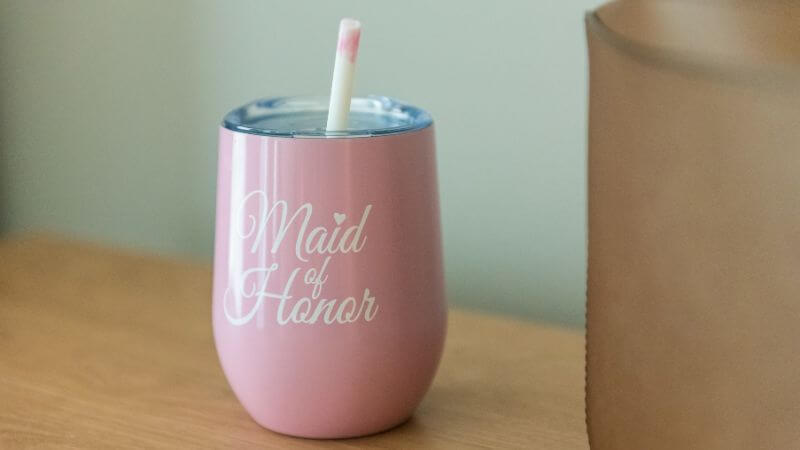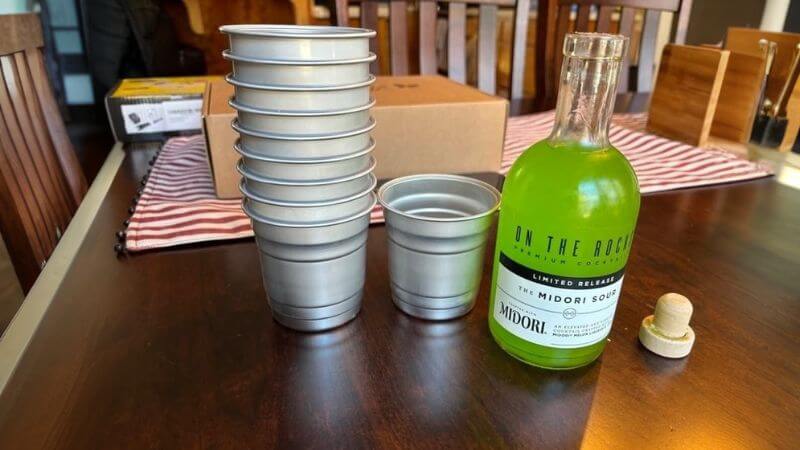Table of Contents
Are you worried about the impact of the disposable cups on the environmental pollution? Are you looking for an environmentally-friendly option for your drinks? In this case, it is necessary to resolve the question — do you prefer aluminum or stainless steel cups?
Both aluminum and stainless steel cups can be reused. Primary features of aluminum cups are lighter weight and higher recyclability. In contrast, stainless steel cutlery is more durable and has good retention of heat. Your choice depends on your specific needs and preferences.
Learn more about the advantages and disadvantages of each material in a more detailed manner to find out which one compliments your lifestyle and your environmental objectives more.

What Are Aluminum Cups and How Are They Made?
In the United States, aluminum cups are made from finshed aluminum, which is a light material with a strong heat transfer capability. The manufacturing procedure consists of heating aluminum and shaping it into a cup, and then polishing it. This kind of cups is appreciated for the fact, that it keeps temperatures of the drinks and is friendly to environment, because of the ability of aluminum to be recycled over and over again and without quality loss.
What Are Stainless Steel Cups and How Are They Made?
Another type of cup is the stainless steel cup, which is made from an alloy of iron, chromium, and nickel, giving it iron durability and corrosion resistance. This involves alloying the raw materials, pouring molten metal into molds to form the correct cup shape, and polishing the surface. Stainless steel cups are durable and do not get scratched or dented easily. Besides, stainless steel cups are specific to their use and do not hold onto any odor or flavor once the beverage is finished. Recycling is possible for stainless steel, although it is more complicated than recycling aluminum.

What’s the Advantage of the Aluminum Cups?
Let us now take a closer look at the benefits of aluminum cups.
Lightweight Design
The fact that aluminum contains low density results in cups that can be handled and transported without any fuss. This feature makes them ideal for outdoor events or even for picnics and camping. After all, their light weight nature means that carrying multiple cups at one time will not be a burden on users.
Thermal Conductivity
Aluminum’s high thermal conductivity property means that heat can easily pass through it. For example, this means that beverages can be served at the most desirable temperatures. A good case in this aspect is the aluminum cup which has a higher retention for a cold drink than a plastic cup thus making it cooler than the alternatives.
Durability
It can be said, without an iota of doubt, that even though they are light in weight, aluminum solo cups are stronger than glass or ceramic. It provides a good degree of durability because it can withstand several drops or impacts without shattering. This makes it a good use for indoors and the outdoors as well.
Cost-Effectiveness
Aluminium cups tend to be less expensive than stainless cups and are thus perfect for consumers looking for cheaper alternatives while still getting quality product. They are cheaper than their steel counterparts but there is still good quality making them accessible to a wide range of consumers.
Eco-Friendliness
Aluminum reusable cups are ideal for the environmentally conscious people due to its sustainability. This is due to how aluminum can also be recycled over and over again; a process which uses only 5% of the energy that would be needed to create new aluminum from aluminum oxide.

What Are the Disadvantages of Aluminum Cups?
Heat Transfer
When heating high grade aluminum for beverage containers it is essential to consider the thermal conductivity—which is quite high, standing at 202 W/K. This implies rapid transfer of heat thereby making it easy for hot drinks to cool faster than what a cup made from stainless steel would do. For those people who would want to take their beverage and not worry that it will cool down in a few moments, this is a drawback feature.
Hygiene Challenges
Not washing the recycled cups properly can lead to the container isolating smells and tastes from the previous occupants thereby afflicting future impacting future drinking experiences. This bottleneck is greatly pronounced while dealing with stronger flavored tan coffee, or citrus juices, tea etc. It is humanly possible to avoid the scenarios of cup isolation by washing them regularly and properly using a mild detergent, and rinsing and drying the cup to the core.
Dent Sensitivity
It is because aluminum is softer than stainless steel among other metals that will tend to resist den features more, so naturally aluminum cups tend to be dented more. This weakness can be unfavorable during shipping or with rough handling and can make the cup lose its beauty and create weak spots in the frame. Using thicker gauge aluminum or aluminum drinking cups that are made with better designs can reduce the level of dents.

What Are the Advantages of Stainless Steel Cups?
Exceptional Durability
Stainless steel is a material that has gained wide acceptance because of its strength and toughness, which makes it impervious to corrosion, scratches, and even dents. This durability means that stainless steel cups are ideal for long-term use whether in the home, in a cafe, or when going for outdoor activities. For instance, even at cases such as camping or sites of construction and use of steel cups, in such an environment, these steel cups will still retain their integrity.
Hygienic Properties
Stainless steel has a solid non-porous coating so it can’t trap bacteria, hold previous odor or locks a taste of that uses before. This attribute enables stainless steel cups (coffee stains and even juices with a high level of acidity) to be used without changing the flavor too much. The cups are also easy to disinfect and dishwasher friendly making them suitable for health-conscious users.
Temperature Retention
These cups are also very effective in retaining the original temperature of the liquids placed inside them because of their double-walled or vacuum insulated designs, making warmer drinks even warmer and colder drinks cooler. They are suitable for a coffee lover or a tea drinker who prefers to take his/her time in savoring the drink.
Sustainability
It’s indeed harder to recycle than aluminum but the longevity of its use greatly compensates for its environmental consequences. When used, the stainless steel cup can be utilized for decades which also helps in reducing dependency on single-use disposable options, thus being environmentally friendly.

What Are the Disadvantages of Stainless Steel Cups?
Higher Cost
Because of the materials they are manufactured with and the production processes involved, stainless steel cups are considerably more costly than many other reusable alternatives. However, the promise of their durability often makes the investment worthwhile for buyers in search of quality.
Weight
Stainless steel cups are made of a denser material than aluminum and hence are heavier. This may be a disadvantage for those users that seek greater portability, such as hikers or travelers. This issue can be somewhat alleviated by choosing smaller sizes or lighter designs.
Cleaning Requirements
The metal cups must undergo extensive cleaning to metallic surfaces because these stains can accumulate water spots or scratches. It is important to maintain them with non-abrasive sponges and specific cleaners such as vinegar solutions in order for the cups to last long in good conditions.

What Are the Key Comparisons Between Aluminum and Stainless Steel Cups?
Environmental Impact
Aluminum and stainless steel cups act as a great substitute for disposable cups and minimize waste. Aluminum has an important advantage in eco-friendliness; it can be recycled an infinite number of times without any loss in quality. For example, recycled aluminum consumes about 5% of the energy required to produce new aluminum. As far as stainless steel is concerned, its great durability reduces replacement frequency, which makes it a valid option for sustainable development as well.
Cost
Aluminum drinking cups are relatively low in cost and are suitable for bulk buying, event organizers, and price conscious buyers. Whereas stainless steel cups are comparatively expensive at first but can be worth the investment in the long run because of how long and sturdy they can be. For instance, aluminum cups may need to be replaced after years of usage, whereas stainless steel options last for decades if taken care of properly.
Durability
Stainless steel is highly durable and is scratch, dent and rust resistant, so it has the benefits of being used for a long time and even in harsh conditions. Whereas aluminum cups are useful for casual usage where strength is not critical but are more vulnerable to dents when subjected to rough use.
Heat Retention
Among hot drink lovers, stainless steel, especially double-walled or insulated containers has the upper hand. On the contrary, aluminum materials seem to be well-liked for cold drinks, hence useful for outings or when refreshments are chilled.
Weight
Aluminum is lightweight, hence enhancing its mobility, which is appropriate for traveling or outdoor activities. On the other hand, users tend to love stainless steel for its weight, which brings an enhanced sturdy and premium feel and is believed to be more of a quality feel.
Ease of Cleaning
However, both of them are very easy to clean, but it seems stainless steel requires one to a little more extra in order to maintain the shine of its material. For instance, the use of water spots can be assisted with oils, treacle solutions, or specialized cleansers. Aluminum cups on the other hand are less affected by marks which make them easier to take care of.
By weighing these factors, consumers can choose the material that best aligns with their priorities, be it affordability, sustainability, or performance.
Frequently Asked Questions
Is it safe to drink hot liquid from aluminum cups?
Yes, Aluminum cups are safe even at high temperatures. However, the high thermal conductivity of aluminum cups can lead to them being hot on the outside, which may cause discomfort or burns if drunk. It may be a good idea to add a sleeve or use a handle when taking quite hot drinks from aluminum cups.
Can aluminum cups be used in dishwashers?
Some manufacturing plants that make aluminum cups state that their products can be put in dishwasher however, hand washing them is most preferable in order to ensure that the finishing of the cups is not damaged or discolored. Consult with the manufacturer’s care guide for precise details.
Do aluminum cups affect the taste of beverages?
Manufactured aluminum cups which are of high quality are usually coated in a way that makes them non porous and this prevents metal from being able to leach into the beverage. A low grade cup however may allow little metallic taste into the beverage and this is true to acidic types of drinks.
Are stainless steel cups safe for all types of beverages?
Yes, A wide range of beverages is fine including both hot and cold ones so that there are no restrictions on drinking any type of beverage with stainless steel cups. They also do not corrode or leach any harmful chemicals and so even acidic beverages like coffee or tea are fine.
Can stainless steel cups go in the dishwasher?
Most pre-manufactured stainless steel cups are intended and designed for dishwasher use. However, because they may develop water stains and scratches, it is generally best to wash them by hand using warm water, mild soap, and a soft cloth. When in doubt, read the care instructions provided by the manufacturer.
Do stainless steel cups retain odors or flavors?
Stainless steel is non-porous and does not absorb odors or flavors, meaning that each beverage tastes as it should in its respective cup. You simply have to clean it properly after use.
Conclusion
The choice of aluminum and stainless steel cups comes down to personal and practical considerations. In the case of aluminum cups, they are lightweight and easy to recycle which particularly explains their popularity amongst consumers on the go and in need of lightweight materials. On the other hand, stainless steel cups are robust and can maintain a certain degree of heat allowing them to appeal to consumers that are interested in durability and quality.








